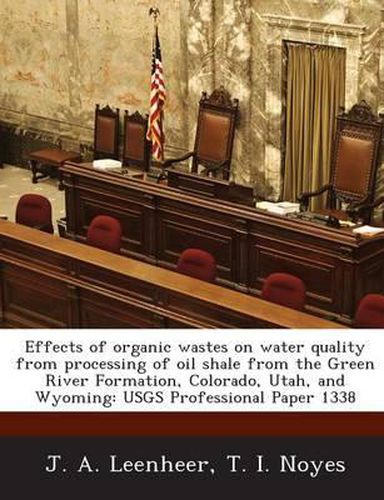Readings Newsletter
Become a Readings Member to make your shopping experience even easier.
Sign in or sign up for free!
You’re not far away from qualifying for FREE standard shipping within Australia
You’ve qualified for FREE standard shipping within Australia
The cart is loading…






A series of investigations were conducted during a 6-year research project to determine the nature and effects of organic wastes from processing of Green River Formation oil shale on water quality. Fifty percent of the organic compounds in two retort wastewaters were identified as various aromatic amines, mono- and dicarboxylic acids phenols, amides, alcohols, ketones, nitriles, and hydroxypyridines. Spent shales with carbonaceous coatings were found to have good sorbent properties for organic constituents of retort wastewaters. However, soils sampled adjacent to an in situ retort had only fair sorbent properties for organic constituents or retort wastewater, and application of retort wastewater caused disruption of soil structure characteristics and extracted soil organic matter constituents. Microbiological degradation of organic solutes in retort wastewaters was found to occur preferentially in hydrocarbons and fatty acid groups of compounds. Aromatic amines did not degrade and they inhibited bacterial growth where their concentrations were significant. Ammonia, aromatic amines, and thiocyanate persisted in groundwater contaminated by in situ oil shale retorting, but thiosulfate was quantitatively degraded one year after the burn. Thiocyanate was found to be the best conservative tracer for retort water discharged into groundwater. Natural organic solutes, isolated from groundwater in contact with Green River Formation oil shale and from the White River near Rangely, Colorado, were readily distinguished from organic constituents in retort wastewaters by molecular weight and chemical characteristic differences.
$9.00 standard shipping within Australia
FREE standard shipping within Australia for orders over $100.00
Express & International shipping calculated at checkout
A series of investigations were conducted during a 6-year research project to determine the nature and effects of organic wastes from processing of Green River Formation oil shale on water quality. Fifty percent of the organic compounds in two retort wastewaters were identified as various aromatic amines, mono- and dicarboxylic acids phenols, amides, alcohols, ketones, nitriles, and hydroxypyridines. Spent shales with carbonaceous coatings were found to have good sorbent properties for organic constituents of retort wastewaters. However, soils sampled adjacent to an in situ retort had only fair sorbent properties for organic constituents or retort wastewater, and application of retort wastewater caused disruption of soil structure characteristics and extracted soil organic matter constituents. Microbiological degradation of organic solutes in retort wastewaters was found to occur preferentially in hydrocarbons and fatty acid groups of compounds. Aromatic amines did not degrade and they inhibited bacterial growth where their concentrations were significant. Ammonia, aromatic amines, and thiocyanate persisted in groundwater contaminated by in situ oil shale retorting, but thiosulfate was quantitatively degraded one year after the burn. Thiocyanate was found to be the best conservative tracer for retort water discharged into groundwater. Natural organic solutes, isolated from groundwater in contact with Green River Formation oil shale and from the White River near Rangely, Colorado, were readily distinguished from organic constituents in retort wastewaters by molecular weight and chemical characteristic differences.